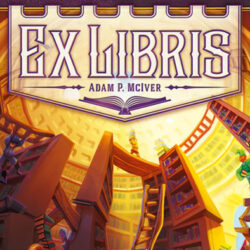In 1883, Jules Richard wrote that once a bibliophile has a collection of more than a thousand volumes, the room where they are kept quickly becomes a shrine – ‘devient vite un temple’. Reid Byers cites this observation (p. 4), and it reflects the central theme of his long and interesting book. He opens with a discussion of the simple rooms that held the clay tablets of Sumer and Babylon, and describes the book-boxes in which the Egyptians and the early Greeks put their papyrus scrolls. The rooms in which these chests were kept define what Byers calls ‘type one’ libraries. Private collections seem to have existed by at least 1500 BCE in Egypt, and were relatively common among scholars by the time of the great philosophers of the Greek ‘Golden Age’.
Tag: libraries
Ex Libris. Designed by Adam P. McIver with art by Jacqui Davis, Adam P. McIver, and Anita Osburn.
The story of Ex Libris is that the Mayor needs to assign a new Grand Librarian, and he’s invited all the town’s book collectors to be considered for the role. So you’re all preparing for the Mayor’s Official Inspector to come and judge your collection — the collector with the best collection (that is, with the most points at the end of the game) wins the job, and the game. In order to build their collections (and gain points) the players collect books following prompts set at the start of the game, and carefully shelve the books they collect over the course of the game.
Mary Clapinson. A Brief History of the Bodleian Library (revised edition). Julia Walworth. Merton College Library.
Taken together, these two recent books provide a succinct – but very satisfying – description of two of the most famous libraries in the world. In both, the text is accompanied by many appropriate illustrations, virtually all of them in color. In what follows, I emphasize the earliest and most formative years of each institution.
Sheila Liming. What a Library Means to a Woman: Edith Wharton and the Will to Collect Books.
The 2,700-plus books at the Mount, Edith Wharton’s historic Berkshire estate, represent only a portion of the novelist’s remarkable collection. Another 2,500 volumes, which one of Wharton’s heirs stored in a London warehouse after her death, were destroyed in the Blitz. And the volumes now in the Mount’s collection themselves survived storage in an English castle (some have the wormholes to show for it) and in a bookseller’s attic before a high-profile (and contentious) negotiation brought them to the Mount in 2006.
Amy Hildreth Chen. Placing Papers: The American Literary Archives Market.
If you are tired of taking acquisition adventures from librarian and bookseller memoirs as proof of the larger trends at play within the literary archives market, this is the book for you. Chen’s pithy study takes us through the views of each stakeholder connected to a typical American literary archival collection, from creator to end user, mainly through both quantitative and qualitative examples using her meticulous dataset of those authors included in the seventh edition of The Norton Anthology of American Literature (hereafter NAAL).





